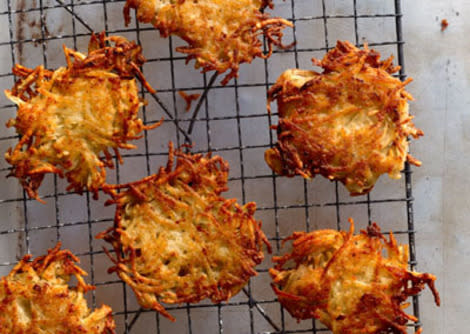Adam Rapoport's Famous Latke Recipe

By Adam Rapoport, Bon Appétit
I got my latke recipe from my mom, Maxine Rapoport, who got it from her mom, who, I'm pretty sure, got it from her mom. So I guess you could say it's a family heirloom. But when I moved to New York and began hosting my own Hanukkah dinners, I started toying with it. I wondered if I could get the latkes even crispier on the outside, and more flavorful. I did my research. My good friend Mitchell insisted that the key to great flavor lay in the onion-to-potato ratio, so I upped my Vidalia count. Good call: The onions introduced a subtle sweetness. I fried the pancakes in a mixture of schmaltz and vegetable oil because, well, chicken fat delivers taste. And I added a step that my mom never bothered with: wringing the water from the grated potatoes for the crispiest latkes possible. Then, instead of packing the potato mixture into patties, I spooned it into the pan, producing crunchy, craggy edges. Are these latkes different from what I grew up eating? Yes. But I imagine that my mother (and grandmother, and great-grandmother) would approve.
Read More: Bon Appétit's Favorite Winter Appetizers
Adam and Maxine's Famous Latkes
Makes 24
Russets are ideal for latkes. Their high starch content means you won't need flour to bind the pancakes. The result? More potato, and a crunchy (not cakey) texture.
Ingredients
3 pounds large russet potatoes (4-6)
1 medium Vidalia, yellow, or brown onions (about 2)
2 large eggs
1/4 cup fine plain dried breadcrumbs
3 1/2 teaspoons kosher salt
2 teaspoons baking powder
1/4 teaspoon freshly ground black pepper
2 tablespoons (or more) schmaltz (chicken fat; optional)
2-4 tablespoons (or more) vegetable oil
Applesauce
Sour cream
Preparation
Preheat oven to 325°. Peel potatoes. Using the large holes of a box grater or the grater disk on a food processor, grate potatoes and onions. Transfer to a large kitchen towel. Gather ends of towel; twist over sink and squeeze firmly to wring out as much liquid as possible. Open towel; toss mixture to loosen. Gather towel; wring out once more.
Whisk eggs, breadcrumbs, salt, baking powder, and pepper in a medium bowl to blend. Add potato mixture. Using your fingers, mix until well coated. (Latke mixture should be wet and thick, not soupy.) Line a large rimmed baking sheet with several layers of paper towels. Set a wire rack inside another large rimmed baking sheet; set aside. Heat 2 tablespoons schmaltz, if using, and 2 tablespoons oil (or 4 tablespoons oil if not using schmaltz; fat should measure about 1/8 inches) in a 12 inches nonstick skillet over medium-high heat. Drop a small amount of latke mixture into pan. If the fat sizzles around the edges, it's ready. (Do not let fat smoke.)
Working in batches and adding more schmaltz and oil to skillet as needed to maintain 1/8 inches fat, drop large spoonfuls of mixture into pan, pressing gently with the back of a spoon or spatula to flatten slightly. (If mixture becomes watery between batches, mix to incorporate; do not drain.)
Cook latkes, occasionally rotating pan for even browning, until golden brown and cooked through, 2 1/2-3 minutes per side. (If small pieces of potato floating in the oil start to burn, carefully strain out.) Transfer latkes to paper towel-lined baking sheet to drain, then transfer to prepared wire rack. Place sheet with latkes in oven to keep warm and crisp while cooking remaining latkes. Serve warm latkes with applesauce and sour cream.
Read More: 31 Delicious Holiday Cookies
4 Steps to Latke Love
Put the Squeeze On: Place the grated potato mixture in a kitchen towel and aggressively wring out as much liquid as possible. This concentrates flavor and prevents sogginess.
Switch Up Your Fat: If you can find schmaltz (chicken fat), get some; it adds extra flavor. Blend it with vegetable oil (you need the oil's high smoke point) for frying. Find it at butcher shops or aviglatt.com.
Test the Temp: If your oil is too hot, you'll burn the outside of the latke before it cooks through. If it's too cool, the potatoes will soak up the oil. Medium-high heat is just right for achieving a beautiful crust. To tell whether the oil is ready, drop in a bit of the mixture. If it sizzles, start frying.
Keep 'Em Crisp: Unless you want to play fry cook while your family eats, you'll need to keep a few batches hot while making the rest. Placing the cooked latkes on a wire rack in a 325-degree oven prevents them from sitting in their grease and lets heat circulate to keep that crunch.
More from Bon Appétit:
Bon Appétit's Guide to Fast, Easy Meals
10 Snacks You Thought Were Healthy But Really Aren't
Post-Holiday Detox Recipes
25 Ways to Use Sriracha
